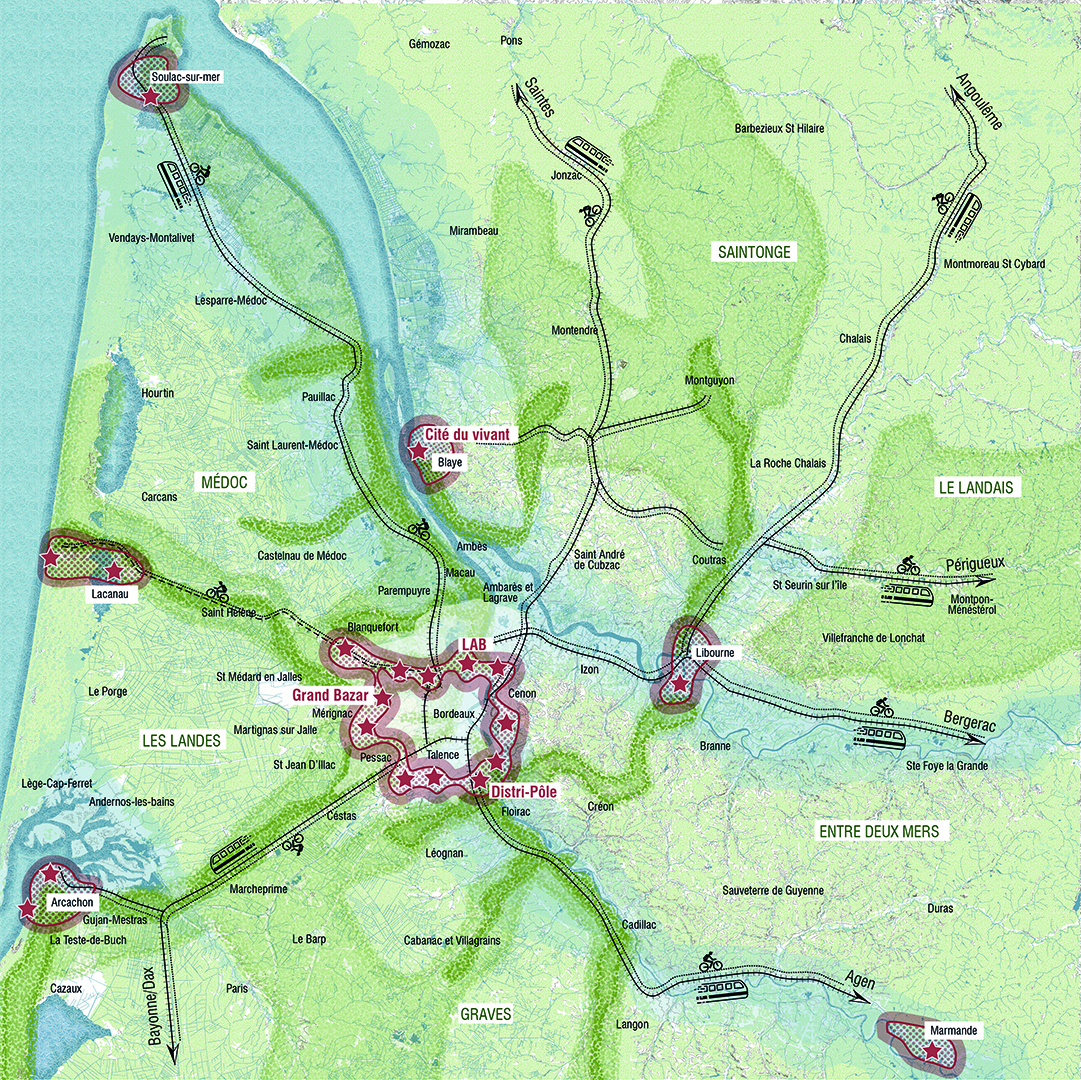
PROJECTIONS FOR
BORDEAUX TOMORROW
As part of a major forward-looking reflection launched by the Metropolis of Bordeaux, ANMA was invited to develop its point of view in the book “2050: Everything Starts Today”, published in June 2019.
ANMA has decided to write a fiction in order to reach as many people as possible. Based on an investigation of a crime of sabotage, the story unfolds across the metropolitan territory and highlights the change in practices and the value system. The urban vision is based mainly on the conservation, transformation and reuse of what already exists, whether it is infrastructure or buildings.

BORDEAUX 2050
03.14.48 – Day of Pi
Since the surveillance center called this morning, Nils has been nervous: four alerts in a month in the Hourcade area only, where the dikes were recently reinforced. He can’t figure why they fail one after the other.
Soon, Mia meets him there. Complaining that the roca-speed was idling. A herd of does had escaped from the O10C corridor and was moving in the reserved lane. Some were very aggressive, which surprised everyone, and of all people a teenage girl who had fancied stroking one: she had suddenly been bitten.
– The devil with Nature’s revenge! It normally takes 10 minutes to get from Eysines to Villenave, today it took me twice that!
Hundreds of crates and parcels are floating around them while electric scooters and drones swing by like flies in an attempt to get their deliveries, to no avail. All shops, services and shared office premises grouped around the logistics platform are no longer at reach. People huddle at the entrance, unhappy that such events have not been taken into account in the development of this relay hub, and yet it is important for local life. Nils knows that something has been planned for this situation, but it has not been triggered: something is wrong.
Yet, on the banks of Arcins, no alert has been reported, which would imply that the new lakeside district has not been impacted. Another proof that its design, although expensive, is very well suited to floods.
Nils and Mia board a drone and fly up and see what is happening at the nearby Lugan Climate Refugee Reception Area. It’s a disaster over there Firefighters are working to evacuate families and rescue people who have taken refuge on the roofs of emergency wooden buildings. In the distance, the villas of Villenave d´Ormond are safe. They were protected by the perimeter walls of the implemented residentialization system, quite illegal for sure, but tolerated because of some well-placed residents, to “protect” themselves from new arrivals.
The water rises quite a distance following the O5D corridor which extends to Gradignan. Bringing the drone closer, Mia notices a strange “leaking” in the dike facing the Distri-Pôle. As they approach near the deflection sheet piling that have already been installed along the dike, Nils feels that they are not facing a natural disaster.
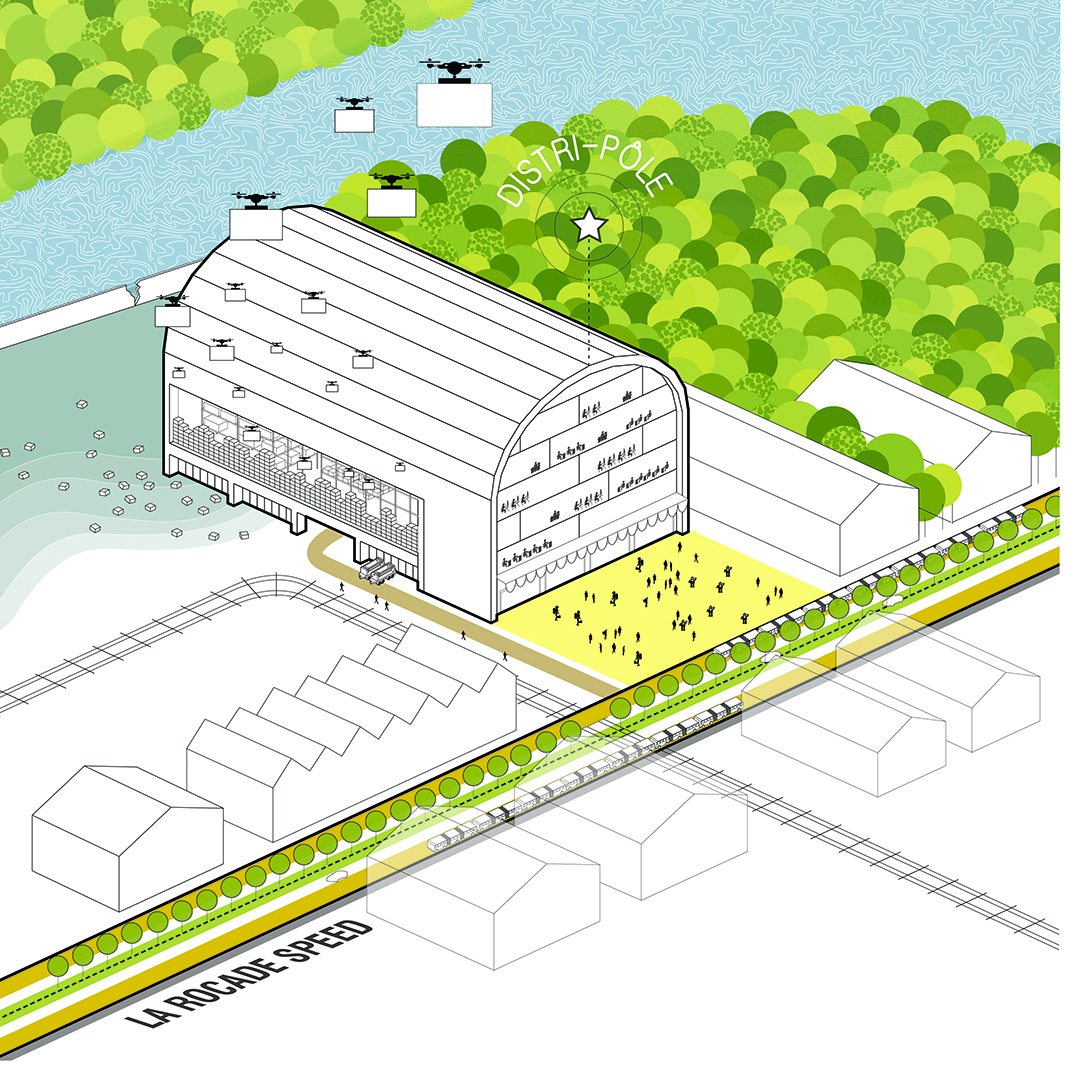
– This breach makes me think of Bouliac.
In the grass at the top of the dike, footprints and a rod catche their attention: a bar made of composite material, black, probably from recycling. They even figure out the hallmark of the factory on the protruding part.
– They feel so goddam confident, they don’t even bother to cover their tracks! Take pictures. This time, we got them!
– What do you mean “they”? Don’t tell me you’re doing it again with your “builders looking for land” scheme !!! Anyway, I’m calling Manu for the samples.
Before leaving, they talk to the manager of the distribution center who complains about the estimated losses and the insurers who no longer cover anything, especially since the heatwave of July 2028, the one that reached 48 ° C. Yeah, Mia recalls that this was the time when setting up the corridors, to renature and decarbonize the city, became the top policy priority. Sometimes to the detriment of some …
– Wait a minute, I know this brand ! There, on your photos! I think it comes from one of the factories set up in La Jallère. For sure it is the LAB, the one that prints construction materials from waste. I deliver a lot in this area because we also have a sorting platform here and they sometimes lack specific materials, and… but wait…!
But Nils and Mia have already left.
– The shortest from here is the river.
– No time to wait for the ferry! Come, let’s take the véloroute des quais. The latest model of self-service electric bike is a ball!
When they get there, they walk along the large parkway that crosses the entire neighborhood and which is crowded. The shop windows display all the diversity of products from the workshops. Many people flock to take advantage of the community-funded 3D printing training sessions; it’s true that this production, better adjusted to the needs of each one, limits wastage.
They find the LAB set up along the O1D corridor, the first that was put in place by the municipality. It had been a long time since Nils had come here. The corridor has truly become impressive. Right in the middle of the district, yet already very wooded, nature is suddenly wild, mysterious. With the heat and humidity that now mark the Bordeaux climate, the trees are gigantic and some are covered with lianas. One can make out the flowing water at the bottom but the “jalle” is inaccessible, reserved for wildlife. All this vegetation gives this district, however dense and urban, a peaceful atmosphere. Nils is enjoying this moment when city and nature seem to be in symbiosis.
The factory manager doesn’t recognize the stamp Mia shows him in the photos. Indeed, it is very close to one of those he has affixed on the products that come out of his workshop, which explains why the manager of the Distri-Pôle could have been wrong. Looking both dejected, he advises them to look around the Grand Bazar of Mérignac, the gigantic recycling center where the exchanges of services and materials are scrupulously traced.
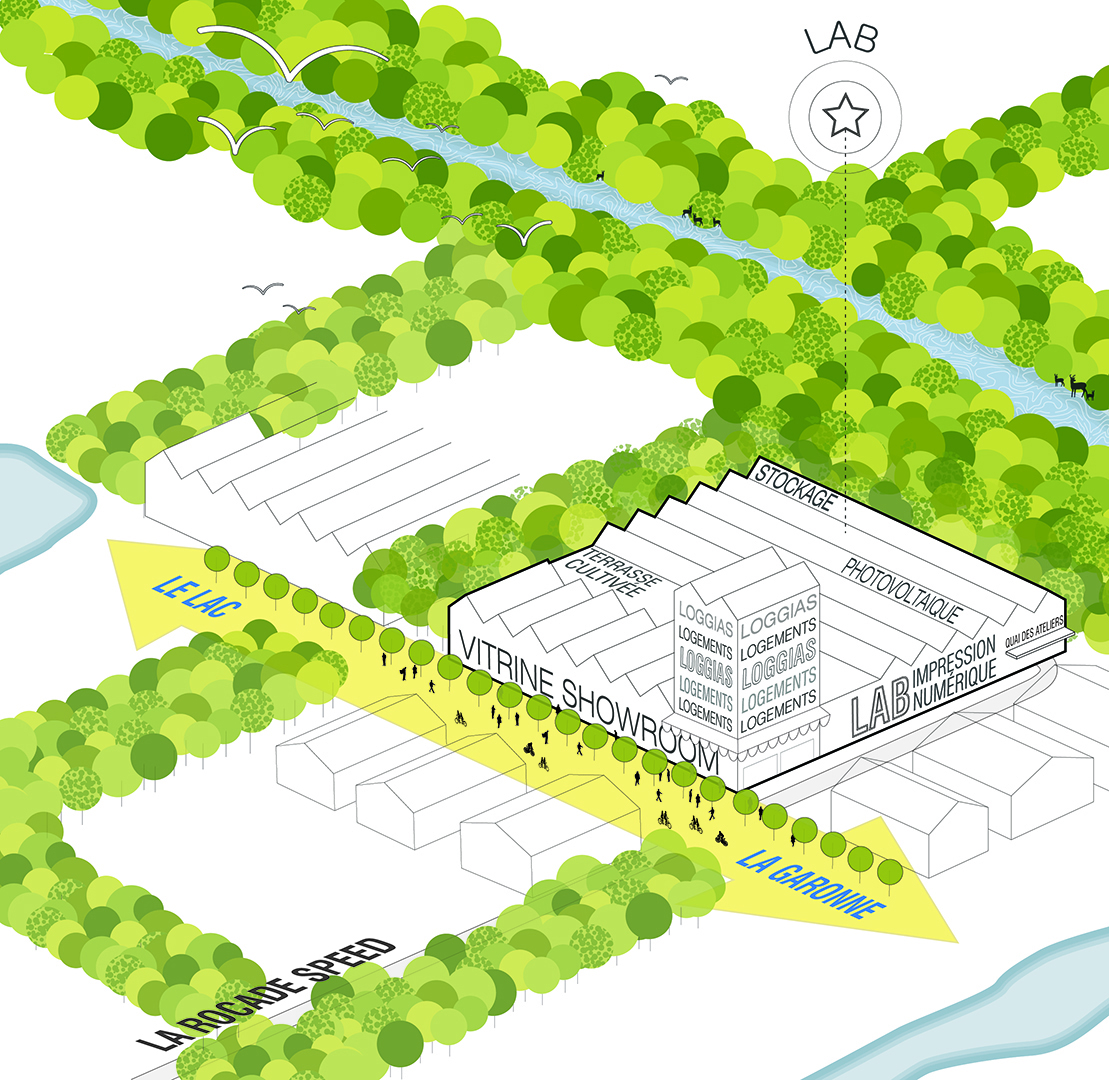
– It would have been too easy. The Grand Bazaar, don’t bother going there, too many possibilities, too many leads to follow.
– Let’s take a break and have lunch!
– Manu just sent me a message: he’s got something new, we have to meet him.
– Well then, let’s meet him halfway, at the Médoquine restaurant
They hop in the tram and then enter the New Boulevards in a cabin suspended above the tracks.
– I would have liked so much to know this time when you could go full speed on the boulevards, slalom on the second lane, Mia sighs; the tracks are now so narrow to give room for vegetation, pedestrians, terraces,… there is now so little room to move around!
– Well I mostly remember traffic jams! Giving more space to vehicles has never solved traffic, on the contrary it only makes it worse! You fantasize something that never existed, Mia!
– Um, I’m convinced that it was one of those extremist green people who did it. They are so convinced that water must flow as widely as possible in the city so that nature can take back its rights …!
On the way, they pass in front of the Tower of he tDébats Publics of the Porte Judaïque. It’s hot, as always: since the public services have become a place of permanent dialogue, the tower is always full. Minimal food, carbon traps, sharing of space, rationing of travel, financialization, community medicine, education for all ages, all the subjects are on the table.
– I believe that tomorrow evening, there is a discussion on the Micro-Mobilities Plan, I’m going to put my two cents in …
– Mia, I recommend the panel discussion tonight on major transport infrastructure instead. The topic is the airport: limitation of air traffic, reuse of parking lots: you’ll have something to debate!
At the metropolitan cafeteria, they are served a plate overflowing with sweet and delicious tomatoes.
– Urban farms in the marketgardener belt must operate at full capacity!
– Right now it’s growing like quackgrass, the restaurateur replies. Thanks to the massive production of compost from all the restaurants and kitchens in the city! And in return, we benefit from advantageous prices and quality products. Just taste these fresh potatoes! It was not the same story last year ! Following the cold snap which had reached -15 ° C, we had to call on the farms of Marmande which are protected by solar greenhouses …
Manu’s arrival reminds him that he has other clients and he slips away.
Manu sits down with them with a disgusted look:
– All this vegan food is for hipsters.
At the same time, he’s not quite sure what to eat since he fell ill after eating half a kilo of cultured meat, Mia thinks.
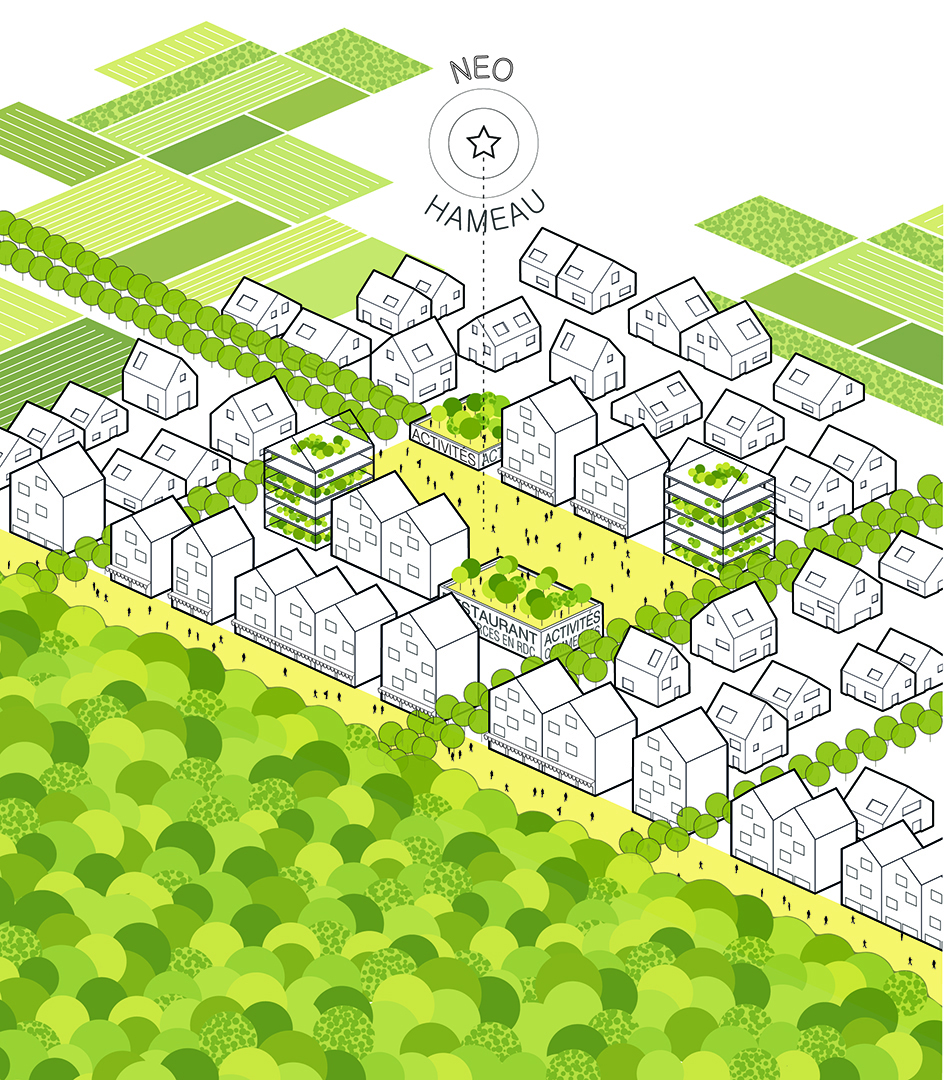
– I dream of going hunting in a corridor! But it is very difficult to escape the security that protects them. I’ve heard that the O5D is the most gamey …
– Show us what you found out Nils cries, who can’t take it anymore.
– Initially, I looked to see if there were any fingerprints on the bar, and I wanted to compare them to the files of suspects for terrorist attacks. These dogs will never stop ruining the lives of those who have already lost everything! he exclaims in sudden anger; but I didn’t find anything. So I did some soil tests. They show that the dyke was not violently broken, but dissolved. I don’t think the bar you located caused the breach in the dike. The samples showed the presence of microorganisms that the usual lab did not recognize. They grow specifically in contact with certain chemical elements. If we identify the species of microorganisms, we may be able to trace back to those who did it, well maybe….
Nils and Mia are not that convinced. But with no other leads, they decide to go to the Cité du Vivant in Blaye. This large international research center on biology was recently relocated to revitalize the Dordogne, like so many structuring facilities which contribute to a better balance of the territories in the Gironde. And that’s good news, the Médoquine has resumed its functions as a station with the reopening of the old railway lines on which a transport now runs at a very regular pace, the Trans’lais.
The trio hops next on the VLBCs (low-consumption light vehicles) which fill the wagon halfway. These bikes with 3 or 4 wheels, solar scooters, and other XXL skateboards with integrated sensors also parade next to the rails, on specially designed lanes. These paths serve, thanks to a clever capillary network, all the autonomous hamlets that have developed in the Metropolis. Installed on the fringes of corridors which become increasingly vast as one moves away from the center of Bordeaux, these hamlets are the only non-continuous form of urbanization permitted by the authorities.
The right to build is granted provided three guarantees are respected: no isolated individual housing, development and management of energy and agricultural facilities which allow autonomous daily operation for the inhabitants of the hamlet (excluding exceptional natural events) and installations of very low-rent facilities where people can work close to home, thus limiting travel. Mia thinks of her parents who were forced to move to one of these hamlets after her childhood home was demolished for the creation of the E2C corridor. If bitterness and resentment had invaded their early years, they now seemed very happy to be part of this neo-village, overlooking the Saint-Médard-en-Jalles corridor.
– Manu, I hope you haven’t forgotten your multi-transport card, as it happens so often! Here they go with it, but the Blayais won’t tolerate it! And wemight take a shuttle there, the regional transport platform says there are two left at the station, I will book one. You will not be able to come with us without your card!
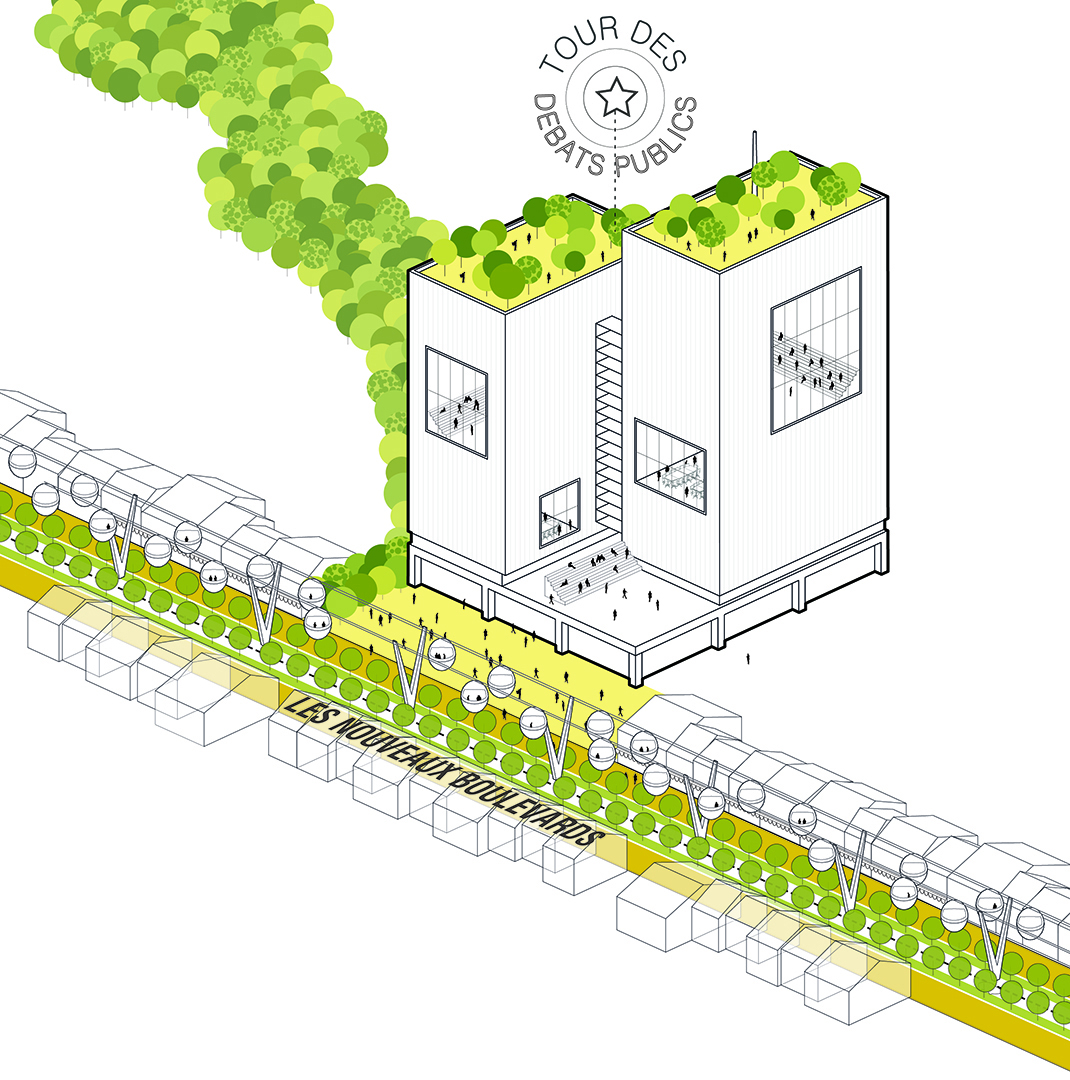
– Oops…
– It’s not that hard! ONE CARD for ALL transport and ALL car parks in the WHOLE Region!
– We’re coming, stop bickering! The shuttle is not necessary, the science center is near the station, this is done on purpose given the number of researchers, students and professionals who frequent the place.
The doctor who takes them in has already received the samples by drone in the morning. He seems worried.
– The microorganisms you have detected have already been spotted in several places in the Metropolis. It’s been about a year since they appeared, each time near an accident. It’s amazing. These microorganisms have the ability to dissolve concrete, steel, wood.
Alerted, Nils gave the investigation department a call to get everything they had about these accidents. An hour later, a reminder makes a compelling list.
Reflecting on his first hypothesis, Nils realizes he’s on the wrong target. Even if it is true that building land is extremely rare in the Metropolis and that sites dedicated to refugees arouse all the envy, it suddenly seems obvious to him that it was the dike itself that was targeted! Indeed, the maintenance of these dikes is fundamental for the entire metropolis. And it’s a lucrative market for businesses and insurance companies …
– Manu, find everything you can on the maintenance contracts for the dikes! I want to know if there has been something brewing in the last year. Meanwhile Mia, dig into the research articles on microorganisms. We need to know all the labs potentially capable of producing this stuff.
A week later, when they meet to celebrate the resolution of this case, Nils, Manu and Mia congratulate each other on the dissolution of the mafia network that was trying to take control of the maintenance of the dikes. By causing disasters, they undermined the current provider and then presented themselves as saviors. The microorganisms were so effective that they even planned to use them on bridges to swap deals. Fortunately they had them cornered!
They got caught red-handed, circling their lab hidden at the end of the O10C corridor. Like all corridors, this one was normally inaccessible, but the network had bribed security and created a loophole into it. The Roca-Speed does had aroused Nils’ suspicion and discovery of the lair soon followed.
– Time to get back to work folks! Protecting the corridors, flushing out hydrogen trafficking, monitoring the compliance of new hamlets, acting against the anti-permaculture brigades … To ensure the smooth operation of the city’s incessant innovations, investigations are keeping up!

PROJECT TEAM
TEXT
Nicolas Michelin
Mélusine Hucault
GRAPHIC ILLUSTRATION
Mélusine Hucault
Emmanuel About
